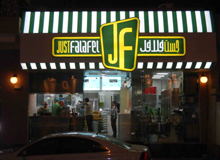Few businesses can claim as meteoric a rise as Just Falafel, an Arabic restaurant chain. From four stores in 2010, the Abu Dhabi-based firm had more than 650 franchises across 15 countries. Sales have grown from 18 million dirhams (US$5 million) to 45 million dirhams (US$12.2 million) between 2011 and 2012. The firm receives up to 300 franchisee requests on some days and it has nearly a million Facebook fans. "We are growing exponentially," says Fadi Malas, Just Falafel’s founder and CEO.
Malas is one among a clutch of Middle Eastern entrepreneurs that are successfully persuading palates in the west and elsewhere to Arabic fare as healthy alternatives to fast foods and a worthy complement to other cuisines. Others include Saudi Arabia’s dates and gourmet foods company Bateel, Lebanese confectioner Patchi, and a Dubai-based shawarma chain Wild Peeta. The recent Gulfood event in Dubai drew 4,200 exhibitors from 110 countries, a record in its 26-year history.
Even as the new brigade of Arabic food marketers stress the health attributes of their offerings, they face several challenges as they grow. For one, many western consumers view Arabic foods as "street food," a perception rooted for some in the Middle Eastern food trucks at university campuses in the U.S. and elsewhere. Second, established competitors could raise concerns about the quality standards and hygiene of Arabic foods. To overcome those, Arabic food marketers must spread awareness about the health benefits, pay close attention to quality, secure the best locations and avoid head-on confrontations with entrenched players, say experts at the Wharton School and elsewhere.
Marketing channels in the west differ significantly from those in West Asia and elsewhere, notes Barbara Kahn, Wharton marketing professor and director of its Jay H. Baker Retailing Center. As Arabic food chains face competition in new markets, they need to understand local market practices, retail supply chains and appropriate pricing, according to her. "These are very important issues and the reason other companies failed (e.g., Carrefour, Walmart, Tesco) at least initially when entering new global markets," adds Kahn, whose research interests include brand loyalty and consumer behavior in seeking variety.
Big Growth Lies Ahead
The gains could be large if Arabic food marketers get their global growth strategies right. Worldwide, Middle Eastern full-service restaurants are poised to grow their combined revenues from US$31.5 million in 2011 to US$42.2 million by 2016 (based on 2011 exchange rates), or nearly 40%, according to Euromonitor International, a London-based research services firm specializing in consumer markets. Middle Eastern fast foods are on a faster growth track, and Euromonitor forecasts a 73% growth in their sales, from US$15 million to US$26 million between 2011 and 2016. They will see their biggest growth in their home markets of the Middle East, Turkey and Africa, followed by Western Europe, Australasia and North America, according to the data projections.
Just Falafel’s Malas is acutely aware of the big markets that await Arabic foods, and the obstacles on the way. A former banker who last worked at Chase Manhattan Bank in London before turning entrepreneur in 1996, he chose to innovate his way into new markets. Traditional falafel is a deep fried vegetarian ball of chickpeas or beans wrapped with salads and sauces in a pita bread. Malas sees his falafel sandwiches fitting in nicely with the growing shift to vegetarian foods and as "an addition to existing food categories instead of eating away [market share] from burgers and pizzas."
Malas "reengineered" the falafel to develop some 10 variants to suit different cuisines like Italian, Mexican, Indian, etc. He did have to overcome "resistance" from skeptics as he introduced falafel burgers and other fare. Getting prominent retail operators to open Just Falafel outlets was also difficult because of the street-food perception, he says. Eventually, acceptance replaced skepticism, "and we proved we can innovate in food," he adds. Today, he works 18 hours a day to keep up with the expansion pressure, and has a staff of five processing franchisee applications.
Just Falafel’s network spans the Middle East and the U.K. This past January, Just Falafel opened an outlet in London’s Covent Garden. It plans 19 other branches in the U.K. and Ireland, including in university cities like Cambridge. Next, it is looking at India, where it is putting together a joint venture to open outlets in Mumbai, Chennai and Ahmedabad. "India is a sweet spot for us, where half the population is vegetarian," says Malas. He also sights the U.S., Canada and Australia as his near-term growth markets.
Health Benefits Lead the Caravan
The record attendance at Gulfood is evidence of the expanded global market for Arabic foods, says Mark Napier, its show director. The event drew more than 75,000 trade visitors from the food industry. "Many of our international visitors come to Gulfood explore new Middle Eastern flavors that they can introduce in their home markets," he says. The number of exhibitors from the Middle East looking to trade in global markets has grown exponentially, he adds.
Napier says the health benefits of Arabic foods were a big attraction. Arabic foods use ingredients like olive oil and sesame seeds that have a multitude of health benefits. Dates are a local delicacy, and are popular for their sweet taste and their nutritional properties, as they are rich in amino acids, dietary fiber, essential vitamins and iron.
Of late, people have begun to recognize the health benefits of camel milk, consumed both plain and as an ingredient in gourmet chocolates, says Napier. Camel milk is witnessing rising demand in United Arab Emirates (UAE) supermarkets and restaurants, he says. The Food and Agriculture Organization estimates camel milk trading could be worth $10 billion in the near future, he informs.
"Consumers are getting more adventurous in the type of fast foods they are eating, especially falafel, and we are seeing chains from the Middle East gaining critical mass," says Michael Schaefer, head of beverages & foodservice at Euromonitor in Chicago. Middle Eastern foods have been around in the U.S., the U.K. and Western Europe for a long time as fast foods, but Schaefer now sees more attempts to make them mainstream.
Building Global Brands
The growing popularity of Arabic foods is good news also for Wild Peeta, a four-year-old Dubai-based firm founded by two brothers. Wild Peeta’s specialty is shawarma, a Middle Eastern grilled meat preparation shaved of vertical, rotating spits and served with breads and salads. "We wanted to create the world’s first global shawarma brand," says Mohamed Parham Al Awadhi, a cofounder. "It is the most popular sandwich thanks to the Greeks, the Arabs and the Turks," he adds, referring to shawarma’s patron base.
Al Awadhi wants to grow his brand’s popularity, but grow its retail footprint cautiously, chastened by some early setbacks. Wild Peeta initially opened two outlets in quick succession, but they did not take off as planned because of wrong location choices and had to close, he says. "We grew too fast and didn’t give ourselves too much time to learn," he adds.
The initial experience "grounded" the Al Awadhi brothers. Wild Peeta reopened in Dubai in March at what Al Awadhi rates as a better location; he says it is less expensive than the first two and more accessible. It plans to open a second outlet, but that will take shape after consolidating the gains from the current location.
Notwithstanding his caution in expansion, Al Awadhi is convinced that Arabic foods will find a bigger place among international cuisines, but that will take time to gain critical mass. "If raw fish found global traction and people are lining up to pay a lot of money for it, then we can sell Middle Eastern food," he says. "It took a long time to bring sushi to where it is today. Middle Eastern foods need time and they will be among the leading foods in the world."
Wild Peeta is actively using social media to promote its food, and has created an online community of loyal fans. As he eyes the U.S. as one of his future markets, Al Awadhi says he would choose places that already have Middle Easterners and communities "where people are open minded," listing San Francisco and New York.
New Markets, New Challenges
However, Arabic food marketers may face unfamiliar challenges in their new markets. "As with moving to any market, the vendor must learn local customs, cultures and regulations," says Kahn. "Many food chains have failed with moving to new global markets because they do not understand this." For example, the best locations will be most likely already occupied, she notes. "Putting a store in the wrong location can lead to failure – e.g. locations where people tend to work and not live, and hence do not shop for groceries." Here, understanding consumer behavior is critical, such as whether they drive and how often they shop, she adds.
Getting consumers to acquire new tastes is also not easy. "Changing consumers’ food habits is very difficult," says Kahn. However, many ways exist to promote a new cuisine, especially if it is healthy and tasty, she adds. "Social media, public relations campaigns and food/restaurant events may help build awareness."
"If a company enters a new market and there is entrenched competition, the competitors will do what they can to thwart the new entrant," says Kahn.
Competition from international brands is familiar territory for Middle Eastern marketers, says Malas. His home market of the UAE has the second highest penetration by global brands after the U.K., he points out. "We already operate in an ecosystem that is at par with the most developed markets in the world."
Focus on Quality, Perceptions
Despite the new buzz around Arabic foods, Schaefer does not expect dramatic changes in how western consumers respond to them. The branding efforts of eatery chains like Just Falafel will elevate the perception of Arabic foods to "better quality fast food, not fine dining." He puts them in the basket of "fast casual" food chains, which have limited menus but with better quality than street food and fast food. He says Mexican food chains have done precisely that, and done it well.
Here, Schaefer cites Chipotle, a chain of Mexican eateries that is popular in many U.S. cities. Such chains have emphasized the use of fresh and high quality ingredients, and designed their restaurants for consumers to see their food made in front of them. "Chipotle came in and offered a fresh and simpler take on the process," he says, noting its "almost fanatical insistence and emphasis on quality and showing where the food is coming from." Nothing short of that model will help higher-quality foods grow demand in the U.S., he adds.
The growth will be gradual for Arabic foods in western markets, says Schaefer. The earliest converts will be in big cities like New York City, London and Chicago, where people are familiar with Middle Eastern food, he says. "Even a tiny fraction (in market share) is going to mean big numbers," he adds. "I see Arabic foods taking that path."



